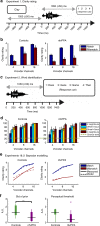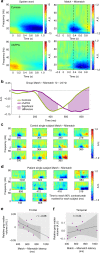Evidence for causal top-down frontal contributions to predictive processes in speech perception
- PMID: 29255275
- PMCID: PMC5735133
- DOI: 10.1038/s41467-017-01958-7
Evidence for causal top-down frontal contributions to predictive processes in speech perception
Abstract
Perception relies on the integration of sensory information and prior expectations. Here we show that selective neurodegeneration of human frontal speech regions results in delayed reconciliation of predictions in temporal cortex. These temporal regions were not atrophic, displayed normal evoked magnetic and electrical power, and preserved neural sensitivity to manipulations of sensory detail. Frontal neurodegeneration does not prevent the perceptual effects of contextual information; instead, prior expectations are applied inflexibly. The precision of predictions correlates with beta power, in line with theoretical models of the neural instantiation of predictive coding. Fronto-temporal interactions are enhanced while participants reconcile prior predictions with degraded sensory signals. Excessively precise predictions can explain several challenging phenomena in frontal aphasias, including agrammatism and subjective difficulties with speech perception. This work demonstrates that higher-level frontal mechanisms for cognitive and behavioural flexibility make a causal functional contribution to the hierarchical generative models underlying speech perception.
Conflict of interest statement
The authors declare no competing financial interests
Figures








Similar articles
-
Predictive top-down integration of prior knowledge during speech perception.J Neurosci. 2012 Jun 20;32(25):8443-53. doi: 10.1523/JNEUROSCI.5069-11.2012. J Neurosci. 2012. PMID: 22723684 Free PMC article.
-
Neural correlates of syntactic processing in the nonfluent variant of primary progressive aphasia.J Neurosci. 2010 Dec 15;30(50):16845-54. doi: 10.1523/JNEUROSCI.2547-10.2010. J Neurosci. 2010. PMID: 21159955 Free PMC article.
-
Causal cortical dynamics of a predictive enhancement of speech intelligibility.Neuroimage. 2018 Feb 1;166:247-258. doi: 10.1016/j.neuroimage.2017.10.066. Epub 2017 Nov 2. Neuroimage. 2018. PMID: 29102808
-
The cortical organization of speech processing: feedback control and predictive coding the context of a dual-stream model.J Commun Disord. 2012 Nov-Dec;45(6):393-402. doi: 10.1016/j.jcomdis.2012.06.004. Epub 2012 Jun 20. J Commun Disord. 2012. PMID: 22766458 Free PMC article. Review.
-
Evidence and implications of abnormal predictive coding in dementia.Brain. 2021 Dec 16;144(11):3311-3321. doi: 10.1093/brain/awab254. Brain. 2021. PMID: 34240109 Free PMC article. Review.
Cited by
-
Anticipation-induced delta phase reset improves human olfactory perception.PLoS Biol. 2020 May 26;18(5):e3000724. doi: 10.1371/journal.pbio.3000724. eCollection 2020 May. PLoS Biol. 2020. PMID: 32453719 Free PMC article.
-
GABAergic modulation of beta power enhances motor adaptation in frontotemporal lobar degeneration.Alzheimers Dement. 2025 May;21(5):e14531. doi: 10.1002/alz.14531. Epub 2025 Feb 19. Alzheimers Dement. 2025. PMID: 39968697 Free PMC article.
-
Dynamic Brain Responses Modulated by Precise Timing Prediction in an Opposing Process.Neurosci Bull. 2021 Jan;37(1):70-80. doi: 10.1007/s12264-020-00527-1. Epub 2020 Jun 16. Neurosci Bull. 2021. PMID: 32548801 Free PMC article.
-
Expertise Modulates Neural Stimulus-Tracking.eNeuro. 2021 Aug 17;8(4):ENEURO.0065-21.2021. doi: 10.1523/ENEURO.0065-21.2021. Print 2021 Jul-Aug. eNeuro. 2021. PMID: 34341067 Free PMC article.
-
Dichotic listening deficits in amblyaudia are characterized by aberrant neural oscillations in auditory cortex.Clin Neurophysiol. 2021 Sep;132(9):2152-2162. doi: 10.1016/j.clinph.2021.04.022. Epub 2021 Jun 4. Clin Neurophysiol. 2021. PMID: 34284251 Free PMC article.
References
-
- von Helmholtz, H. Helmholtz’s Treatise on Physiological Optics, Wisconsin, Vol. 3 (Optical Society of America, 1925).
Publication types
MeSH terms
Grants and funding
LinkOut - more resources
Full Text Sources
Other Literature Sources

